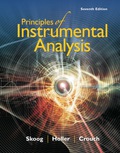
Concept explainers
(a)
Interpretation:
The given operation should be performed by using binary numbers and after that the final binary number obtained should be converted back to decimal.
Concept introduction:
Rules of Binary addition:
Binary sum of
Binary sum of
Binary sum of
Answer to Problem 4.7QAP
Explanation of Solution
We will convert the decimal to binary as follows:
Divide
Now divide
Now divide
Hence the binary equivalent of
Similarly, we can find the binary equivalent of
The sum is,
----------
-----------
The decimal equivalent of sum is,
(b)
Interpretation:
The given operation should be performed by using binary numbers and after that the final binary number obtained should be converted back to decimal.
Concept introduction:
Rules of Binary addition:
Binary sum of
Binary sum of
Binary sum of
Answer to Problem 4.7QAP
Explanation of Solution
we will convert the decimal to binary as follows:
Divide
Now divide
Now divide
....................................…………
....................................…………
Now divide
Hence the binary equivalent of
Similarly we can find the binary equivalent of
----------------
-----------------
(c)
Interpretation:
The given operation should be performed by using binary numbers and after that the final binary number obtained should be converted back to decimal.
Concept introduction:
Rules of Binary addition:
Binary sum of
Binary sum of
Binary sum of
Answer to Problem 4.7QAP
Explanation of Solution
we will convert the decimal to binary as follows:
Divide
Now divide
....................................…………
....................................…………
Now divide
Hence the binary equivalent of
Similarly, we can find the binary equivalent of
------------
-------------
(d)
Interpretation:
The given operation should be performed by using binary numbers and after that the final binary number obtained should be converted back to decimal.
Concept introduction:
Rules of Binary multiplication:
Binary product of
Binary product of
Binary product of
Answer to Problem 4.7QAP
Explanation of Solution
we will convert the decimal to binary as follows:
Divide
Now divide
....................................…………
....................................…………
Now divide
Hence the binary equivalent of
Similarly, we can find the binary equivalent of
-----------
--------------
--------------
Want to see more full solutions like this?
- A bicycle accelerates from 5 miles per hour to 15 miles per hour. Does its energy increase or decrease? Is the change in potential energy or kinetic energy?arrow_forward1-13 Define the following terms: (a) Matter (b) Chemistryarrow_forwardA students drivers license lists her height as 5 feet, 5 inches. What is her height in meters?arrow_forward
- which of these is NOT a physical property of matter?arrow_forwardDetermine which of the following properties areintensive and which are extensive: (a) length,(b) volume, (c) temperature, (d) mass.arrow_forwardThe radius of a copper (Cu) atom is roughly 1.3x10−10 m. How many times can you divide evenly a 223.3−cm long piece of copper wire until it is reduced to two separate copper atoms? (Assume there are appropriate tools for this procedure and that copper atoms are lined up in a straight line, in contact with each other. Round off your answer to an integer.)arrow_forward
- The diagram in (a) shows a compound made up of atoms of two elements (represented by the green and red spheres) in the liquid state.Which of the diagrams in (b) to (d) represent a physical change, and which diagrams represent a chemical change?arrow_forwardPerform the following mathematical operations, and express the result to the correct number of significant figures.arrow_forwardHow many days are in 41,700 minutes? (Assume exactly 24 hours in a day). Express your answer with the appropraite number of significant figures and a unit.arrow_forward
- What is the minimum mass of magnetite Fe3O4, a iron ore, from which 165.g of pure iron could be extracted? Be sure your answer has a unit symbol, if necessary, and is rounded to the correct number of significant digits.arrow_forwardA person's heartbeat is 66 beats per minute. If his/her heart beats 3.1e9 times in a lifetime, how long (in whole years) does the person live? Disregard leap years.arrow_forward
 Principles of Instrumental AnalysisChemistryISBN:9781305577213Author:Douglas A. Skoog, F. James Holler, Stanley R. CrouchPublisher:Cengage Learning
Principles of Instrumental AnalysisChemistryISBN:9781305577213Author:Douglas A. Skoog, F. James Holler, Stanley R. CrouchPublisher:Cengage Learning Introduction to General, Organic and BiochemistryChemistryISBN:9781285869759Author:Frederick A. Bettelheim, William H. Brown, Mary K. Campbell, Shawn O. Farrell, Omar TorresPublisher:Cengage Learning
Introduction to General, Organic and BiochemistryChemistryISBN:9781285869759Author:Frederick A. Bettelheim, William H. Brown, Mary K. Campbell, Shawn O. Farrell, Omar TorresPublisher:Cengage Learning Introductory Chemistry: An Active Learning Approa...ChemistryISBN:9781305079250Author:Mark S. Cracolice, Ed PetersPublisher:Cengage Learning
Introductory Chemistry: An Active Learning Approa...ChemistryISBN:9781305079250Author:Mark S. Cracolice, Ed PetersPublisher:Cengage Learning Living By Chemistry: First Edition TextbookChemistryISBN:9781559539418Author:Angelica StacyPublisher:MAC HIGHER
Living By Chemistry: First Edition TextbookChemistryISBN:9781559539418Author:Angelica StacyPublisher:MAC HIGHER Chemistry: Principles and ReactionsChemistryISBN:9781305079373Author:William L. Masterton, Cecile N. HurleyPublisher:Cengage Learning
Chemistry: Principles and ReactionsChemistryISBN:9781305079373Author:William L. Masterton, Cecile N. HurleyPublisher:Cengage Learning World of Chemistry, 3rd editionChemistryISBN:9781133109655Author:Steven S. Zumdahl, Susan L. Zumdahl, Donald J. DeCostePublisher:Brooks / Cole / Cengage Learning
World of Chemistry, 3rd editionChemistryISBN:9781133109655Author:Steven S. Zumdahl, Susan L. Zumdahl, Donald J. DeCostePublisher:Brooks / Cole / Cengage Learning





